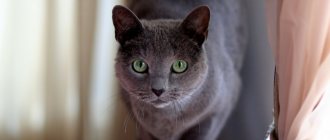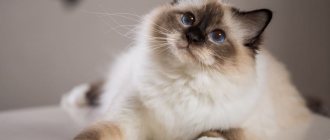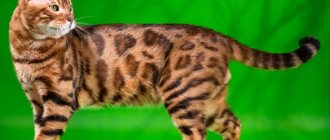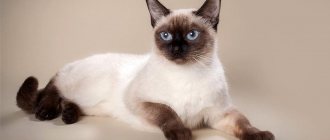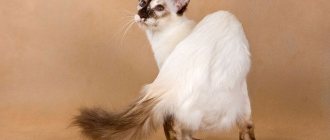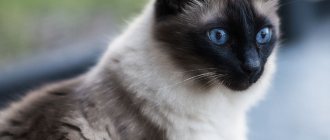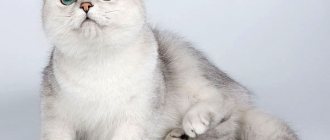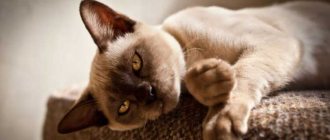A Bengal cat is a piece of wild nature in your hands, a companion with whom you will never get bored. Thanks to their wild ancestors, Bengals have some unique features:
- exotic leopard color;
- charming plasticity;
- muscular build;
- love of water and water procedures;
- excellent jumping ability;
- strong hunting instinct;
- playfulness and dislike of being alone;
- increased activity;
- friendly attitude towards dogs;
- good health.
Bengals are, first of all, luxury. Not everyone can afford it. The price of a purebred kitten from a good nursery amounts to thousands of dollars. The cost is determined by the color of the baby. The more a kitten resembles its wild ancestor, the more it is worth.
Breed characteristics
How difficult is it to care for the breed? | There are no particular difficulties. You need to care for your Bengal just like a regular house cat. |
Do Bengals need special food? | The diet of the breed is no different from the menu of other domestic cats. |
What size do they reach? | This is a fairly large breed. She has pronounced sexual dimorphism. Males weigh 6–9 kg, females 3–5 kg. |
Besides color, does the breed have any similarities to its wild ancestors? | Cats have hind legs that are longer than their front legs, and this gives the animal a special gracefulness to its movements. They also have a silky coat, and they have a special coat structure, as well as the “ugly duckling” stage inherited from their ancestors - phasing. |
What is phasing in Bengal cats? | Phasing is a protective gray fluff that covers the bright color. It appears at 1.5 months. At this age, in nature, kittens leave their mother's den and need camouflage. Babies of all wild cats are susceptible to phasing. |
At what age do Bengals acquire the characteristic color of the breed? | By 3–4 months, phasing usually disappears. But the color is finally formed before the age of 8. At this age, cats become sexually mature. |
Why are kittens of this breed so expensive? | The breed is not very common and difficult to breed. And breeding work requires significant financial investments. All this affects the price of kittens. However, in each litter there are more and less valuable kittens. The most expensive ones are with a phenotype as close as possible to the standard. |
Are Bengals hyperactive cats? Can they live in an apartment and not create chaos around them? | Pets can be mischievous. For them, running along window sills and jumping on the sofa is just a game. Even as they grow up, they remain kittens in temperament. But they have high intelligence. They are easy to train and quickly understand what they are allowed to do and what they are not allowed to do. |
Do Bengals leave marks in the house? | Unfortunately, animals of two sexes mark their territory. And during the period of rutting and estrus, the night calls of the sexual partner can also be heard far away. The problem can be solved by sterilizing pets. |
Is it true that Bengal cats have a special relationship with water? | Bengals love water. They enjoy playing with a stream of water, splashing water from basins left unattended. And before drinking, they instinctively rake out the non-existent algae in the container with their paw. |
They say Bengal cats don't shed. So are they suitable for allergy sufferers? | Representatives of the breed have short, silky hair. She doesn't shed much. But this does not mean that pets do not cause allergies. Moreover, for allergy sufferers it is not so much the fur that is dangerous, but the saliva and other secretions of animals. |
How does a Bengal cat behave in the house? | The cat chooses one “favorite” in the family and accompanies him everywhere. But she also loves to play with other people she knows well. |
Attitude towards children and other family members | Bengals are very sociable. They play with both children and adults. |
Attitude towards other animals, dogs | They get along well with animals. Preferred playmates are small breed dogs. They say that a Bengal is a puppy in a cat's body. |
Do Bengals need walking? | If possible, pets should be taken for a walk. They quickly get used to the harness and walk with pleasure. |
What gender should you choose a kitten as a pet? | Males are more massive than females, but females are more graceful. As for character, everything is individual. Choose the kitten that you like best. |
How long do Bengal cats live? | Average life expectancy is 12–15 years. There are also centenarians reaching their 20th anniversary. |
Advantages of the breed
- Has an extravagant appearance. This is a real indoor leopard with a good disposition.
- This is a strong, agile animal with a strong hunting instinct.
- Bengal is an intellectual. He grasps everything on the fly and quickly learns to understand his owner.
- His ability to train and remember commands is unique. This is a talented student who can be taught to perform various tricks.
- Friendliness and sociability are in his blood. Despite their physical strength, all Bengals are not aggressive. They don't bite or scratch.
- One of the cleanest animals is the Bengal cat. The description of the breed says that they have a silky coat. They take care of her themselves. Pets are bathed very rarely; as a rule, this is done before exhibitions.
- An interesting voice, not like the usual meow. The range of sounds is very wide - from simple rumbling to purring and clicking of the tongue. Owners note that these sounds resemble barking.
- Larger than most breeds. The average weight reaches 5–8 kg.
- These cats are excellent jumpers. Thanks to their elongated hind legs, they make long and high jumps of amazing strength.
Disadvantages of the breed
- The breed is considered one of the most expensive. A cat named Kato holds the Guinness Book record for being the most expensive. In 1998, a London resident bought it for 41 thousand dollars.
- The high price has led to the emergence of unscrupulous breeders who want to make money on the popularity of the breed. More and more kittens are being born with genetic abnormalities.
- Pets need physical activity. You need to walk with them at least once a week, and preferably more often.
- Socialization needs to be given significant attention. It is important to teach babies to use their hands, otherwise they will grow up wild.
- The passion for marking territory was passed on to domestic animals from their wild ancestors. Only castrated animals do not have this extremely unpleasant habit.
- The high activity and playfulness of the breed will not appeal to pedantic people who value order. Mini leopards love to run around everywhere, turning over flower pots or stacks of neatly folded things.
- They are extremely curious, interested in the contents of cabinets and chests of drawers with slightly open doors.
Basic Rules
There are no purebred kittens that do not need care at all. It all depends on the characteristics of the breed. In the case of Bengals, it is necessary to ensure:
A lot of attention is paid to feeding Bengals. It must be of high quality and balanced. Premium ready-made food or fresh natural products without salt, spices, or other undesirable additives are suitable. The remaining points are also very important.
“Neutered Bengals sometimes become overweight. If your pet’s ribs are difficult to feel, you need to reduce the daily portion by 10%, then continue monitoring your pet’s weight.”
Free access to water
Most cats are wary of water, but not Bengals. This is their favorite toy. Mini-leopards enjoy playing with water: dipping their paws into it, catching sunbeams, and watching the flowing stream. This must be taken into account when caring for Bengal kittens.
To drink you need fresh, clean water, a convenient container, and a suitable place. You will need a large enough bowl made of heavy material: metal, ceramics, glass, so that the kitten cannot turn it over. Place the container where there is a waterproof covering. The pet will not limit itself to drinking, he will definitely start playing with water, the space around the bowl will be covered with splashes.
You need to wash the bowl and change the water regularly. Various contaminants fall into the container from the cat's paws, which quickly make the water unfit for drinking. Some Bengals prefer running water. For drinking, you will need a fountain; the device can be purchased at a pet store.
“Smart Bengals who love to watch flowing water are quite capable of learning to open the tap in the absence of their owners. An indoor fountain will protect you from gigantic utility bills.”
Bathing and grooming
A healthy Bengal kitten has short, shiny fur with a characteristic spotted coloring. The undercoat is scanty, so they are not brushed often, once or twice a week. Bengals love to swim, but water procedures are recommended for them only in certain cases:
For bathing, you need to use a special shampoo to which the kitten is not allergic. There should be no problems with the procedure; Bengals bathe with pleasure. If the coat looks clean, there is no need to bathe the kitten on a schedule. Bengal kittens and adults are distinguished by cleanliness; they diligently lick their fur.
Bathing before the exhibition allows you to improve the condition of your pet’s coat and its appearance. Skin problems with proper care are extremely rare. Your veterinarian will recommend a shampoo for your specific situation. Proper grooming for Bengals includes regular examination of the eyes and ears to remove dirt, as well as trimming the tips of the nails. The last measure will help preserve the surface of the furniture from damage.
The place where Bengal lives
The corner where the Bengal kitten lives should look like this:
If a Bengal kitten does not run around the house most of the day, but lies quietly in a corner, it needs to be shown to a veterinarian. This may be a sign of the onset of a serious illness. A healthy Bengal runs, jumps and plays with pleasure. He can crash into furniture without any damage to the body, and jump onto the wall with a running start. Experienced owners are not surprised by claw marks at a height of about two meters.
A vertical play complex up to the ceiling with steps and shelters will appeal to your Bengal. If circumstances permit, it is better to place such a toy in every room. The lack of an equipped play area will not stop the mini-leopard. He will climb onto tables, window sills, cabinets, stands, curtain rods, and any other high places to jump off.
Bengals willingly play with homemade toys. A paper bow or feather on a string will delight them. Any rustling objects arouse constant curiosity. Kittens of this breed are sprinters, they run fast and soon get tired. Ten-minute periods of play activity alternate with periods of rest.
To prevent a playful pet from falling out of an open window, all openings should be covered with nets. This also applies to vertical cracks that appear when opening a window. A kitten is quite capable of getting stuck in a small opening. You need to remove all wires and cables that could get tangled in under the baseboard or in a box.
We need locks on all cabinets and cabinets where substances potentially dangerous to Bengals are stored: food, drinks, household chemicals, medicines. Smart kittens quickly learn to open unlocked doors; they can get poisoned due to their insatiable curiosity. The refrigerator is equipped with child protection.
Communication with the owner
Bengal kittens love communication and suffer alone. Despite a bit of wild blood, they are kind and affectionate. You need to interact with a Bengal kitten every day: pet it, talk to it, play. A harness is required for outdoor walks. An active pet can run away from its owner in a matter of seconds, and this is dangerous for its health.
Adult cats and female cats wear a collar; it is more comfortable. Before a walk, it is necessary to treat the withers with an anti-tick preparation. Kittens tolerate a car ride quite calmly, but you should not leave your pet there alone, even for a short time.
An important point in caring for a Bengal is teaching it the word “no”. From early childhood, a pet must learn that there are prohibited actions, for example:
At the moment of committing a “crime” you need to use one of the methods of influence:
Then you should clearly pronounce the word “no”. Gradually the kitten will get used to it and will immediately respond to speech. You cannot shout at a Bengal, beat him, rub his nose in the Skoda, or punish him after the fact. This will only disorient him and will not bring the desired result. For communication, you can buy another kitten. Bengals get along well with other breeds. Favorite entertainment is noisy games at night.
Character and behavior of the Bengal kitten
| Characteristic | Peculiarities |
| Intelligence | High |
| Learning ability | High |
| Need for communication | High |
| Attitude towards children | good |
| Relationship with other cats | good |
| Relationship with other pets | Difficult, Bengals love to hunt birds and rodents |
“Usually a Bengal kitten treats his owner with special love, who spends more time with him. For a pet to get along with other family members, they should pay attention to it, feed it, and play.”
Comfortable toilet
Breeders teach kittens to use the litter box; the new owner will have to develop this skill. Bengals are clean people, they like to roll their feces as deep as possible. It is better to use wood filler, not helium. A toilet in the form of a house will provide the pet with the necessary degree of privacy. After cleaning, a barely noticeable cat odor should remain in the litter box. It is not recommended to use caustic chemicals containing chlorine or strong fragrances for cleaning.
“Some Bengals are so picky about cleanliness that the litter box has to be cleaned after every use. For the pet’s convenience, two trays are placed at once.”
High intelligence is a characteristic feature of Bengals. Many of them quickly become accustomed to the toilet using a special attachment. It is important to ensure that the plumbing is used for its intended purpose, some kittens try to turn it into a personal swimming pool, and this is unhygienic and dangerous.
Photo of a Bengal cat
Ready food
If you start feeding your pet with ready-made food, keep in mind that you will be doing this for the entire time. After all, Bengal cats become accustomed not only to one type of food, but also to a company. They react sensitively to changes in diet and may even get sick.
What food is best to feed a Bengal kitten? Of the entire range of ready-made food, only a few brands are suitable for representatives of this breed:
- Royal Canin.
- "Okana."
- "ProPlan".
- "Sanabel."
However, when buying pate or dry granules, keep in mind that the jars and bags must be marked “For kittens.”
Character and behavioral characteristics
A real domestic leopard with an easy-going character is the domestic Bengal cat. She did not inherit her character from her wild relative. From her ancestor she inherited her color, love of water and an unusual voice. Otherwise, this animal has all the features of a pet. His hunting qualities appear only in games.
At exhibitions, this breed's temperament is assessed especially strictly. Only calm and affectionate animals receive positive ratings. Aggression and aloofness are considered a marriage. Individuals with such traits are not allowed for breeding.
Basic character traits
- Representatives of this breed are smart and quick-witted, and quickly get used to the tray and scratching post. Many useful skills are learned simply by observing people's behavior.
- They are independent and freedom-loving. They don't like being picked up against their will.
- Bengal women single out one person in the family to whom they become more attached than others. They love to watch him. At the same time, they try not to let him out of sight for a minute.
- Pets are very sociable. Loneliness is not good for them. They run wild and often leave marks on their owner’s things in retaliation.
- High gaming activity continues into old age. They are interested in outdoor games at any age.
- Security qualities appear more often in males, especially if they live in a country house. Bengals protect their territory from other cats.
- Pets do not accept screaming or physical punishment. Any manifestations of aggression towards them are contraindicated.
- Leadership qualities are clearly expressed. If there are other animals in the house, the Bengal will try to become the head of the pack. When keeping cats of the same sex, fights can occur.
Peculiarities of Bengal behavior in the house
- This is an excellent mousetrap. His hunting instinct is very developed. He hunts exactly like his wild relatives, setting up ambushes and waiting for the right moment.
- Pets are characterized by caution and prudence. Males will not go straight into a fight. They, like real hunters, will wait until the opponent loses his vigilance and attack from behind.
- Cats show emotions with various sounds. The characteristic rumbling most often accompanies meals and displays of tenderness towards the owners.
- They do not show aggression towards all family members. They behave warily with strangers at first. Their trust must be earned.
- They love to play with children. For pets, a child is a good playmate. In the game he does not show aggression, but sometimes he puts out his claws, like any cat.
- This is a partner animal, the Bengal loves to take part in all household chores
- Pets are especially active in the mornings and evenings. Favorite pastime is hide and seek.
- They have a lot of fun drinking water. They dangle their paws in the water, clearing the bowl of imaginary duckweed. A program turns on in the cats' heads, and they imagine that they are drinking water in at least the Ganges River.
- Genetically they have another feature. Domestic leopards, like their ancestors, prefer to relieve themselves in water. Therefore, they can easily be taught to go to the toilet.
- They love walks outside. Unlike most breeds, they get used to a harness well and look forward to every appearance.
Socialization of kittens
Knowing how to raise a Bengal kitten, you will never encounter his aggression. It is when hunting that the tailed “child” can be sharp (he is excellent at catching mice). But the pet will get accustomed to the family pretty quickly. Interestingly, raising such a cat is not particularly difficult. These creatures are very smart and observant, so they learn many useful skills from people with interest.
Socialization of the kitten takes place without unnecessary problems. True, the animal, as a rule, treats family members, including children, differently (more precisely, the cat chooses one owner). A pet can watch its pet for hours, it does not like to let it out of its sight.
Care and maintenance
An exotic and expensive breed, oddly enough, does not require special care. Like other pets, they require good nutrition and some hygiene procedures. They don’t need to be brushed daily; they don’t need expensive care cosmetics either. It is enough to follow simple rules of care.
Basic rules of care
- Pets have special fur. It is short and silky. Cats shed lightly and do not need to be brushed. They take care of their fur themselves. During seasonal shedding, it is enough to remove dead hairs with a rubber glove.
- Bengals are rarely bathed. The procedure will bring a lot of positive emotions, because water is almost a native element for this breed.
- An active cat usually grinds its claws down on its own. It is necessary to install a scratching post for him. Inspect the claws once a week, and if necessary, cut off their dead part with special nippers.
- Eyes should always be clean. The accumulated secretion in the corners is removed with a piece of clean cloth.
- Ears are regularly cleaned of wax and dust with cotton swabs. During the procedure, a special product is used.
Pet hygiene
If a Bengal cat, as mentioned above, is fed with high-quality food and periodically given vitamins, then such a pet will look healthy. His coat will always be smooth, shiny and thick.
Therefore, there is no special care for his fur coat. The only thing is that you can periodically comb the animal with a special brush to rid it of dead hairs.
You should bathe your pet only if it is very dirty or if it has fleas and they need to be removed with a special shampoo.
You should also clean your ears only when necessary.
But it is necessary to trim the claws. Even if a Bengal has a scratching post, this procedure will not hurt him. Moreover, this way you will definitely protect your furniture and wallpaper. Claws need to be trimmed with a special nail clipper for cats. The nail should only be cut from the edge.
Feeding Bengal cats
The wild ancestors of the domestic Bengal in nature feed on game caught during hunting. These can be small rodents, birds, lizards, and sometimes fish. Moreover, small cats eat them completely - with the skin, offal and stomach contents. This way they provide themselves with the necessary vitamins, minerals and fiber. When composing your pet’s diet, you need to take this feature into account.
The Bengal's gastrointestinal tract is structured differently than most breeds. From their wild ancestors they inherited a short intestine and a very sensitive stomach. And the food that is considered habitual for the yard musk is simply not digestible for the mini-leopard. And due to the abundance of animal protein, your pet may have loose stools.
Natural food or prepared food?
As a rule, owners have to choose between natural feeding and ready-made diets. When choosing ready-made food, many problems disappear - you just need to purchase food of at least Premium class and provide your pet with free access to water.
High-quality food is sold in specialized pet stores, but not in a supermarket or market. They come in different types. There is food for both kittens and older cats. But some breeders, not unreasonably, believe that Bengals do not show up in all their glory when drying. And the reproductive rate of cats on natural food increases. Therefore, even adherents of dry food often choose mixed feeding.
When choosing natural food, it is important to properly prepare your pet’s diet and use only fresh and high-quality ingredients. The basis is meat products. But they need to be supplemented with vegetables, cereals, and other sources of plant and animal protein, not forgetting vitamin and mineral supplements. Finding a suitable menu is not easy, and you will have to test it on your pet yourself. This applies to both “drying” and natural feed.
Feeding mode
Depending on age, food is given with the following frequency:
- 1–2 months – up to 6 times;
- up to 3 months – 4 times;
- up to 5 months – 3 times;
- starting from 6 months – 2–3 times a day.
Features of natural feeding
The main menu of Bengals consists of meat (at least 60%), grains (up to 20%), vegetables (20%) with the addition of fish oil, vitamins, minerals and other substances (calcium, glucosamine).
The Bengal cat's diet includes the following foods:
- poultry and poultry by-products (it is necessary to take not only offal, but also parts rich in cartilage - necks, heads);
- rabbit meat and lean beef (including offal - tripe, lung, heart);
- raw or boiled quail eggs;
- Boiled cereals (buckwheat, rice), you need to be careful with rolled oats;
- boiled or raw vegetables (carrots, pumpkin, zucchini, beets, cucumber), eggplants and potatoes should not be given;
- low-fat fermented milk products and cottage cheese;
- vitamin complexes.
Many breeders feed Bengals raw chicken necks. To do this, they are frozen for 2 weeks, then thawed, doused with boiling water and crushed. For adult cats, it is enough to beat them with a hammer; for kittens, the necks are crushed in a meat grinder or blender.
Fish is given occasionally. This is not a staple for Bengals. It can cause problems with the urinary system. Cow's milk is completely contraindicated for cats. It causes diarrhea. Instead, they give yogurt without filler or yogurt.
When switching to a new food, you need to monitor not only your pet’s well-being, but also its stool. If your stool smells too strong, you need to make adjustments to your diet. This also applies to the smell of urine.
Kitten diet
Until 4–5 weeks, the kitten feeds on its mother’s milk. Then other foods are introduced into his diet. The smaller the kitten, the shorter the intervals between feedings. Portions are calculated individually.
As a first complementary food, babies are given scraped chicken meat, after dousing it with boiling water. Later you can give chopped meat products. Then the kitten is “introduced” to cereals and eggs are added to the menu. Vegetable supplements are introduced last. For this purpose, vegetables are boiled and chopped. The pet is switched to an adult diet at 8–12 months of age.
Catering rules
Until the age of one month, babies, as a rule, are fed only breast milk. After 4–5 weeks, new foods begin to be introduced into the diet. This could be a scraped chicken breast, scalded with boiling water. A little later it will be veal, beef or turkey cut into small pieces. Add porridge with eggs to your diet. Be sure to include raw and boiled vegetables: carrots, pumpkin, beets, broccoli, cauliflower.
Keep in mind that at the age of 8–9 months, a cat’s weak point is the stomach (diarrhea often occurs). Experts recommend feeding animals very carefully and choosing premium food:
- Husse;
- Grandorf;
- Acana;
- Royal Canin;
- Orijen;
- Fitmin (grain-free).
The packaging must indicate that the food is intended for feeding kittens. Pay attention to the age recommendations on the packaging. Some kittens have individual intolerances and skin allergies - in this case, purchase hypoallergenic formulations.
Consider the physical activity of Bengals. For neutered cats with a tendency to obesity, low-calorie recipes are suitable. Try not to give such economical options as Felix and Whiskas.
There should always be fresh water in the bowl, which should be changed 1-2 times a day.
What proponents of natural nutrition should know:
- 80% of the diet should be meat, the best option is beef without fat.
- 10–15% – edible bones: neck, joints, cartilage (except tubular).
- 5–10% – tripe: chicken heart, stomach, lung.
- You can also give chicken, rabbit, and veal as meat.
- The meat is first frozen and served raw.
- You can sometimes feed them boiled pieces.
- Liver is given rarely and little by little.
- Pork and lamb are prohibited for Bengals.
- You cannot offer hot or cold food.
- Cats are given boiled, boneless sea fish; cats do not need fish.
- Healthy dairy products include kefir, fermented baked milk, and cream.
To breed “little leopards” and have healthy offspring, take care of vitamins and minerals. A veterinarian will help you make the right choice.
Upbringing
The efforts of the owner determine how cute the kitten will grow up to be. The breed is not particularly difficult to train. Its representatives easily remember all the requirements placed on them. They get used to the tray quickly. But they can walk by if the cat litter box is not very clean. Therefore, it is better to use wood filler. It masks odors and is pleasant to rummage through. And Bengals tend to bury their excrement. Therefore, choose a pot with high sides for them.
Bengals are very playful. They should have their own toys. Otherwise, pets will find replacements for them in the form of the owner’s things. If you don't want your animal to seek adventure, play with it as often as possible. This will help establish contact with the purr.
It is important to teach the animal to respond to the “No” command. At first, it can be combined with pinching the baby’s neck. This is how his mother cat taught him, and this touch is familiar to him. But you should not use violence against your pet. This will undermine his trust in you. Damaged relationships will be difficult to renew.
If you plan to walk your pet outside, teach him to calmly respond to the collar. Always wear a comfortable harness when walking in the city or outdoors. These animals are very curious. Without a leash, they can harm themselves by going to explore unknown worlds.
Bengals not intended for breeding are neutered before the age of 6 months. This is a simple operation. Cats tolerate it well. Sexually mature cats not only create inconvenience in the house, leaving marks everywhere, but can also run away during the “hunt.”
How to educate and toilet train
Raising these feline babies is an important process for their owner. First of all, the kitten needs to be toilet trained. This is not always easy to do, since these creatures are so squeamish that they sometimes refuse to even visit their litter box. To avoid this problem, buy wood filler for the toilet. If even after this the “Bengal” does not want to go to the litter box and relieves himself in another place, sprinkle the surface with table vinegar or citrus fruits, and your pet will not appear there again.
Raising your tailed pet is simply necessary. Spend more time with him as he has a very playful personality. It is important that the “Bengali” has his own toys, otherwise he will catch and start having fun with everything he comes across, right down to your clothes.
Remember: it is necessary to teach the cat the “No!” command in a timely manner.
To do this, first combine a verbal command with lightly pinching the kitten's neck. However, do not try to hit him - violence will not help your pet understand what you want from him. When walking, try to put a harness around the cat's neck. You need to accustom him to a leash from an early age, then he will not behave nervously during walks.
Health, tendency to disease
This is a hardy breed with good health. The first Bengals only had problems with the gastrointestinal tract. Pets still often have intestinal disorders. But over time, other diseases began to appear in pets. These are hypertrophic cardiomyopathy (HCM) and flat chest syndrome (FCK) in kittens. Allergies are not that uncommon.
As for the weak immune system, it is characteristic of lines in which matings between close relatives were allowed more than once. Such individuals must be regularly vaccinated and dewormed.
Disease Prevention
- A well-chosen diet - the food must be fresh and of good quality.
- Annual examinations with a veterinarian - an experienced specialist will identify most dangerous diseases at an early stage.
- Vaccination - kittens are vaccinated in the nursery, then the new owner must adhere to the vaccination schedule against the most common feline diseases.
- Control of parasites – the Bengal needs to be protected from helminths, ticks and fleas.
- Sterilization – if animals are not involved in breeding, they must be sterilized. There is no other option. There is no such thing as “giving birth for health.”
List of contraindicated products
When developing a diet for your kitten, do not forget that some foods are simply contraindicated for him. These primarily include milk - it causes stomach upset. But yogurts, kefir and yogurt will become an important source of protein.
You should immediately give up potatoes and eggplants - Bengals tolerate them very poorly.
Also, don't get carried away with fish. In the wild, Bengal cats eat it extremely rarely, and therefore are not very adapted to digest it. In addition, frequent consumption of fish causes serious problems with the urinary system.
Choosing and caring for a kitten
If you just choose a pet, the choice is made on the baby you like best. The main thing is that he is healthy. This is evidenced by clean eyes, good appetite, shiny coat, and absence of swelling near the anus. When choosing a show-class pet, there are more requirements. The baby must meet the standard. This applies to color, exterior and character.
Three types of color are considered classic:
- rosetted (roset) – spots have a light base with a dark edging;
- marbled – dark patterns on a light background;
- spotted color (spotted) with evenly colored spots on the pet’s fur.
There are also more rare colors: lynx, mink, sepia. Until recently, Bengals were dominated by warm coat tones. Today the blue color is recognized, and snow Bengal cats have appeared. Moreover, the color of kittens does not appear immediately. Only in sexually mature animals does it become as bright as possible. The new owner can only guess what color a 4-month-old baby will have. Therefore, it is important to buy kittens only from reputable breeders.
Starter kit for rehoming a Bengal kitten
It will be different in each nursery. As a rule, it includes:
- contract of sale;
- veterinary passport with vaccination records;
- pedigree or metric indicating registration in the club;
- food that the baby is accustomed to;
- toilet filler;
- recommendations for feeding a kitten.
Nail cutting
If you haven't already de-clawed your Bengal cat (a decision many support since your kitten needs to protect itself), grooming your cat should include a little nail trimming.
While some people use regular nail clippers for this task, we recommend that you purchase nail clippers designed for cats. The blade of these nail clippers should be sharp so that you don't have to press too hard on your cat's paws to trim the nails.
Please note that this advice does not only apply to Bengal cats; Your other cats (and dogs) will certainly benefit from the extra care you give them.
Breed standards in the WCF system
| Weight | From 4 to 8 kg. Cats weigh less than cats. |
| Appearance | Medium to large size, muscular and strong elongated body. |
| Temperament | Affectionate character, lack of aggression. |
| Torso | Powerful and elongated. |
| Head | Relatively small, slightly elongated. The skull has a convex shape behind the ears. The transition of the head to the neck is smooth. |
| Muzzle | Full and wide. The whisker pads are large and convex. |
| Chin | Strong, in line with the tip of the nose. |
| Eyes | Oval, almost round, moderately large. The color depends on the coat color. The brighter it is, the better. |
| Ears | Medium to small, wide set. Quite short, wide base, rounded tips. |
| Nose | Big and wide. |
| Neck | Long, strong, muscular. |
| Wool | Shorter than average length, may be longer in kittens. Delicate and silky, dense texture. |
| Drawing | Marbled, rosette and spotted. Maximum clarity and contrast. |
| Color | Brown patterned in different colors: brown, sepia, mink, lynx. |
| Paws | Strong, medium length. They have large rounded feet. |
| Tail | Thick, medium length. Tapers towards the end, with a rounded tip. |
| Defects |
|
How many times to feed a Bengal kitten
It depends on the age of your pet. Naturally, babies are fed much more often than adult cats. For example, a kitten between one and two months old needs to be fed six times a day.
A three-month-old Bengal needs four meals a day, and a kitten aged five months can reduce the number of meals to three. A six-month-old mini-leopard gradually switches to adult mode, that is, it eats twice a day.
History of the breed
The Bengal cat is a hybrid of a domestic cat with a wild Bengal cat (Prionailurus bengalensis) as a result of the work of phenolenologists. In the 1960s, American scientist Jane Mill brought a wild Bengal cat from Taiwan to Arizona. Either she wanted to save a wild animal in this way (the species was threatened with complete extermination), or she simply decided to buy it as a souvenir.
In the house of an American woman, a small leopard accidentally “became friends” with a domestic cat, resulting in the birth of offspring. This is how the idea of creating a breed with the appearance of a leopard and the character of a domestic cat arose.
In 1963, Jane brought a representative of the wild species from Asia for breeding work and bred it with the American Shorthair. But in 2 litters, the males were born sterile, but wild females with domestic cats gave birth to offspring capable of reproduction.
The work was long. But she was crowned with success. For a very long time, Bengals were not recognized by any phenological association because of their wild ancestors. But in the 80s they finally got to the exhibition, where they created a sensation. And in 1991, the breed was recognized and given official status.
Cleaning Bengal ears
As we've already said, you need to do your best to keep water out of your Bengal cat's ears while bathing; In truth, Bengal cat care and traditional cat care have a lot of overlap here.
However, you should make an effort to clean your Bengal's ears. You need to start by examining his ears. You need to make sure that there is no foreign object or organism (such as mites) hiding in your cat's ears.
Then you can move on to the actual cleaning process. At this point, you will use a veterinarian-approved ear cleaner rather than water. Simply apply some cleanser to a soft cotton pad and gently wipe away any dirt you find around your cat's ears. You may have to tuck your cat's ears back a little to get the job done, so be gentle.
What dry food should you pamper your pet with?
Ready-made food is considered a more balanced food. But they also have disadvantages.
| Advantages | Flaws |
|
|
However, most of the disadvantages are inherent exclusively in cheap options. More expensive ones contain high-quality products, vitamins and various nutritional components.
Feed is divided into 4 groups based on quality:
- Economy class: “Kitekat”, “Whiskas”.
- Premium class: “Hills”, “Bozita”, “Royal Canin Bengal Adult”,
- Super-premium class: “Arden Grange”, “Cimiao”, “1st Choice”, “Chicopee adult cat”.
- Holistic: “Orijen”, “WildCat Etosha”, “Chicken Soup”, “Acana”, “CARNILOVE Salmon for Adult Cats – Sensitive & Long Hair”, “Eukanuba Adult with Chicken”
Important!
Food for Bengals should not have a fat content higher than 20%.
Small carnivores have very sensitive digestive systems, so the best choice for them would be a holistic diet. Let's take a closer look at some options from this group.
- "WildCat Etosha": good composition with a vitamin complex. Contains a lot of protein, while there are no cereals. The only drawback is the price - 3 kg costs 2,400 rubles.
- “Eukanuba Adult with Chicken”: optimal protein content for Bengals. It also has a good composition, but contains wheat, which contributes to the rapid weight gain of the cat. Price - 4416 rubles per 10 kg.
- "Orijen": fish is used as a source of proteins and fats. But legumes are responsible for carbohydrates, which are not recommended for Bengal cats. But it contains a large amount of vitamins and probiotics, which have a good effect on intestinal flora. Price for 5.4 kg - 3999 rubles.
Take a responsible approach to the decision to purchase food: this breed has a hard time with a change in diet. It’s better to check with the breeder what the domestic leopard ate and according to what diet.
Important!
You cannot mix food of different manufacturers and consistencies in one meal.
If you want to diversify your pet's diet, it is recommended to give wet food. But choose the same manufacturer and product line. Maintain the proportion: 75% of the daily requirement is dry food, the rest is wet. For show cats, use the 50/50 formula.
Make sure your cat always has clean water at room temperature.
Natural food
Meat should be the basis of nutrition for animals of this breed.
If feeding a Bengal is based on natural products, the risk of dehydration of his body is reduced: even with a reduced intake of drinking water, the cat receives liquid from meat and vegetables. Properly selected natural food helps reduce the risk of developing urolithiasis and diabetes, and prolongs the life of your pet. The optimal diet for an animal is meat and vegetable supplements. This mixture of products will ensure normal functionality of the gastrointestinal tract.
Veterinarians recommend introducing new types of food into the menu gradually and carefully. It is desirable that the prepared diet does not change throughout the animal’s life. Before introducing a new type of product into a Bengal cat’s diet, it is advisable to test it in small quantities: add a little to the food and watch the pet’s reaction.
Contraindicated:
The diet of these animals should not include duck.
- Fatty meat: pork;
- duck;
- goose;
- mutton;
- turkey meat.
Recommended food
An adult pet is fed 2-3 times. per day, in one serving 200-400 g of food. Recommended types of food for a Bengal cat:
These fluffies can be treated to carrots.
- Raw lean meat - at least 70% of the daily portion. It is useful to give chicken, rabbit, veal. To prevent the animal from becoming infected with parasites, it is recommended to store meat in deep freeze. Before eating, cut into small pieces, but do not grind into mince, and pour over boiling water.
- Meat by-products: chicken gizzards;
- heart;
- lungs;
- some liver.
- bird's neck;
- pumpkin;
- buckwheat;
